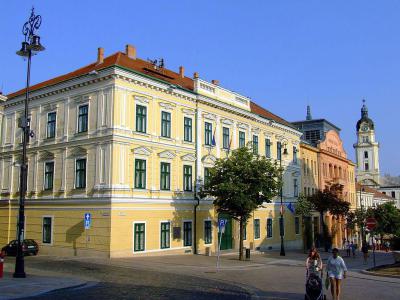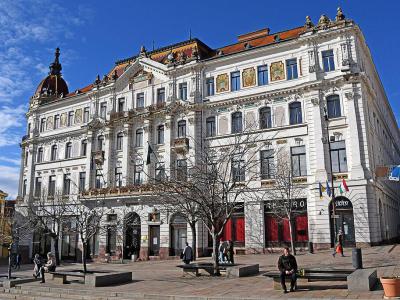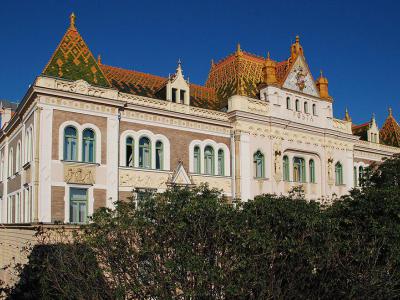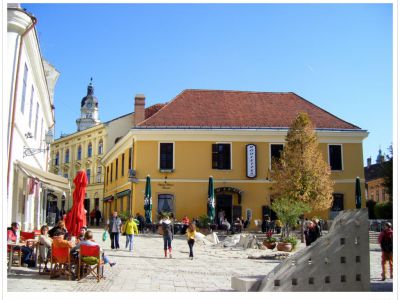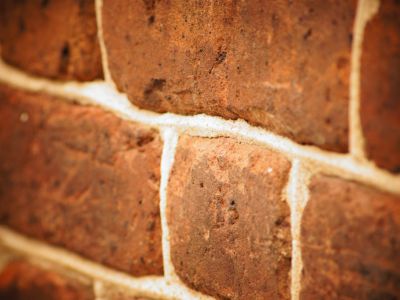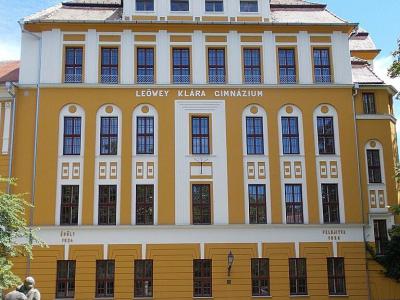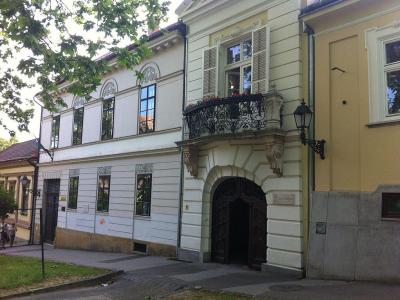
Historical Architecture (Self Guided), Pecs
The city of Pecs is rich in history, art and culture. This is due to the fact that the city's territory has been the site of intersection of different civilizations through the centuries. Magnificent palaces, original constructions of administrative buildings and other wonderful masterpieces by famous architects will amaze you when you discover the beauty of the architecture of Pecs!
How it works: Download the app "GPSmyCity: Walks in 1K+ Cities" from Apple App Store or Google Play Store to your mobile phone or tablet. The app turns your mobile device into a personal tour guide and its built-in GPS navigation functions guide you from one tour stop to next. The app works offline, so no data plan is needed when traveling abroad.
Historical Architecture Map
Guide Name: Historical Architecture
Guide Location: Hungary » Pecs (See other walking tours in Pecs)
Guide Type: Self-guided Walking Tour (Sightseeing)
# of Attractions: 9
Tour Duration: 1 Hour(s)
Travel Distance: 1.7 Km or 1.1 Miles
Author: hollyg
Sight(s) Featured in This Guide:
Guide Location: Hungary » Pecs (See other walking tours in Pecs)
Guide Type: Self-guided Walking Tour (Sightseeing)
# of Attractions: 9
Tour Duration: 1 Hour(s)
Travel Distance: 1.7 Km or 1.1 Miles
Author: hollyg
Sight(s) Featured in This Guide:
- City Court
- The County Hall
- City Hall
- Postal Palace
- The Building Complex of the Elephant House
- The Copy of a Building in Zagreb
- Klara Leowey High School
- The House of Civil Communities
- The Bishop's Palace
1) City Court
The City Court of Pecs, standing on Szechenyi Square, is an elegant example of eclectic architecture designed by Imre Schlauch. Built in 1891, the building's history is deeply intertwined with the evolving functions of this central location. During the Ottoman era, the site hosted the bath of Pasha Gazi Kaseem, a reflection of the Turkish influence in the city. However, by 1722, it had been repurposed as a prison. Later, when Civic Casino shareholders acquired the land, a theatre was established, bringing a cultural flair to the area before it was ultimately demolished to make way for the City Court.
Szechenyi Square itself is the heart of Pecs, a focal point rich in history and surrounded by architectural gems such as the Mosque of Pasha Qasim, the City Hall, and the Baranya County Hall. The square's gentle slope enhances its dynamic urban layout, with grand facades contributing to the city's distinct charm. The presence of the City Court among these landmarks further underscores its significance in the historical and administrative landscape of Pecs.
Szechenyi Square itself is the heart of Pecs, a focal point rich in history and surrounded by architectural gems such as the Mosque of Pasha Qasim, the City Hall, and the Baranya County Hall. The square's gentle slope enhances its dynamic urban layout, with grand facades contributing to the city's distinct charm. The presence of the City Court among these landmarks further underscores its significance in the historical and administrative landscape of Pecs.
2) The County Hall (must see)
The County Hall of Pecs is one of the most striking buildings in Szechenyi Square, embodying a rich architectural history and artistic craftsmanship. Built in 1897, this imposing structure serves as the seat of Baranya County. The building stands on the site of the former Czyndery House and Cseby House, where Emperor Joseph II once stayed during his visit to Pecs in 1770. In 1895, the Pecs-Baranya Central Savings Bank acquired the site and constructed its headquarters, which remains a focal point of the square today. The bees and beehives adorning the façade symbolize the institution’s financial origins.
Among its most remarkable artistic features are the elaborate decorations, many of which were crafted by skilled foremen from the renowned Zsolnay factory. The building’s roof, originally adorned with intricate tile patterns, was largely destroyed in a fire in 1954. Though the structure was later rebuilt with a simpler roof design, the remaining original center pattern showcases the ingenuity of Vilmos Zsolnay, whose patented eosin glaze and pyrogranite technique revolutionized ceramic craftsmanship. These techniques, acclaimed at the 1878 World’s Fair in Paris, remain visible across Hungary, notably in the Hungarian Parliament Building, the Gellert Baths, and Pecs’ own post office.
The County Hall’s historical layers go beyond its 19th-century origins. The front space of the building, facing the street, was initially constructed by Jesuits between 1716 and 1726, incorporating tombstones from a Turkish cemetery. Inside, visitors can admire stunning frescos by Erno Gebauer above the stairs, depicting the foundation of the first university in Pecs.
Adding to the building’s charm is the small park in front of it, where a marble bust of Leonardo da Vinci stands, offering a quiet space for reflection amidst the city’s historic core. Today, the County Hall remains a key architectural and cultural landmark in Pecs, reflecting the city’s deep connection to both Hungarian history and artistic excellence.
Among its most remarkable artistic features are the elaborate decorations, many of which were crafted by skilled foremen from the renowned Zsolnay factory. The building’s roof, originally adorned with intricate tile patterns, was largely destroyed in a fire in 1954. Though the structure was later rebuilt with a simpler roof design, the remaining original center pattern showcases the ingenuity of Vilmos Zsolnay, whose patented eosin glaze and pyrogranite technique revolutionized ceramic craftsmanship. These techniques, acclaimed at the 1878 World’s Fair in Paris, remain visible across Hungary, notably in the Hungarian Parliament Building, the Gellert Baths, and Pecs’ own post office.
The County Hall’s historical layers go beyond its 19th-century origins. The front space of the building, facing the street, was initially constructed by Jesuits between 1716 and 1726, incorporating tombstones from a Turkish cemetery. Inside, visitors can admire stunning frescos by Erno Gebauer above the stairs, depicting the foundation of the first university in Pecs.
Adding to the building’s charm is the small park in front of it, where a marble bust of Leonardo da Vinci stands, offering a quiet space for reflection amidst the city’s historic core. Today, the County Hall remains a key architectural and cultural landmark in Pecs, reflecting the city’s deep connection to both Hungarian history and artistic excellence.
3) City Hall (must see)
The City Hall of Pecs stands as a striking example of Neo-Baroque architecture with subtle eclectic elements, embodying the rich history and cultural diversity of the city. Completed in 1907, the building represents the third incarnation of Pecs' municipal center following the end of Turkish rule.
The first town hall was erected in 1695, symbolizing a new era after Ottoman occupation. However, the structure underwent multiple reconstructions, first in 1710 after a fire, and again in 1834, when local architect Jozsef Piatsek transformed it into a refined Classicist building. By the late 19th century, Pecs' expansion necessitated a grander seat of government, leading to the construction of the current City Hall, designed by Adolf Lang.
One of the most enchanting features of the City Hall is its bell tower, which has resonated across Szechenyi Square since 1871. Every hour, the carillon melodies mark the passage of time, intertwining with the daily life of the city. This enduring tradition has become an auditory symbol of Pecs, much like the iconic Zsolnay ceramic tiles that adorn buildings throughout the city.
Located in Szechenyi Square, the historic heart of Pecs, the City Hall shares its surroundings with other architectural and cultural landmarks. The square, once a medieval marketplace, remains a focal point of urban life. To the north stands the Pasha Qasim Mosque, a testament to the city's Ottoman past, now converted into a church. On the southern side, a unique Zsolnay fountain, featuring oxen heads spouting water, further enhances the square’s artistic legacy.
Today, the City Hall serves as the seat of the General Assembly of Pecs, continuing its role as an administrative and cultural hub. More than just a government building, it is a reflection of Pecs’ identity as a "Borderless City," embracing the diverse heritage of Hungarians, Croatians, Serbians, and other communities that have shaped its history. Its grand facade, crowned with the city's coat of arms, stands as a proud testament to Pécs’ resilience, artistic spirit, and enduring charm.
The first town hall was erected in 1695, symbolizing a new era after Ottoman occupation. However, the structure underwent multiple reconstructions, first in 1710 after a fire, and again in 1834, when local architect Jozsef Piatsek transformed it into a refined Classicist building. By the late 19th century, Pecs' expansion necessitated a grander seat of government, leading to the construction of the current City Hall, designed by Adolf Lang.
One of the most enchanting features of the City Hall is its bell tower, which has resonated across Szechenyi Square since 1871. Every hour, the carillon melodies mark the passage of time, intertwining with the daily life of the city. This enduring tradition has become an auditory symbol of Pecs, much like the iconic Zsolnay ceramic tiles that adorn buildings throughout the city.
Located in Szechenyi Square, the historic heart of Pecs, the City Hall shares its surroundings with other architectural and cultural landmarks. The square, once a medieval marketplace, remains a focal point of urban life. To the north stands the Pasha Qasim Mosque, a testament to the city's Ottoman past, now converted into a church. On the southern side, a unique Zsolnay fountain, featuring oxen heads spouting water, further enhances the square’s artistic legacy.
Today, the City Hall serves as the seat of the General Assembly of Pecs, continuing its role as an administrative and cultural hub. More than just a government building, it is a reflection of Pecs’ identity as a "Borderless City," embracing the diverse heritage of Hungarians, Croatians, Serbians, and other communities that have shaped its history. Its grand facade, crowned with the city's coat of arms, stands as a proud testament to Pécs’ resilience, artistic spirit, and enduring charm.
4) Postal Palace
Standing as a testament to both history and architectural grandeur, the Postal Palace on Jokai Street is one of Pecs' most striking landmarks. Built between 1902 and 1904, this eclectic-style masterpiece was designed by architect Erno Balazs as part of Hungary’s postal service modernization. Before its construction, postal services—including mail handling, telegraph, and telephone operations—were scattered across different locations in the city. The Postal Palace brought these essential functions under one roof, a long-awaited solution first envisioned in 1896.
The building's ornate façade is a blend of French Renaissance influences, Secessionist elements, and intricate reliefs that reflect its postal heritage. Among its most remarkable features are the ceramic decorations and roof tiles crafted at the famous Zsolnay Factory, a hallmark of Pecs' artistic tradition. The painted coat of arms and various reliefs further emphasize the building’s postal identity.
Pecs played a pioneering role in Hungary’s telecommunications history, being the second city after Pozsony (Bratislava) to open a telephone exchange in 1885. The Postal Palace remains a fully operational post office, continuing its legacy while preserving the early 20th-century craftsmanship that makes it a jewel of Hungarian architecture.
The building's ornate façade is a blend of French Renaissance influences, Secessionist elements, and intricate reliefs that reflect its postal heritage. Among its most remarkable features are the ceramic decorations and roof tiles crafted at the famous Zsolnay Factory, a hallmark of Pecs' artistic tradition. The painted coat of arms and various reliefs further emphasize the building’s postal identity.
Pecs played a pioneering role in Hungary’s telecommunications history, being the second city after Pozsony (Bratislava) to open a telephone exchange in 1885. The Postal Palace remains a fully operational post office, continuing its legacy while preserving the early 20th-century craftsmanship that makes it a jewel of Hungarian architecture.
5) The Building Complex of the Elephant House
Nestled in the heart of Pecs, between Szechenyi Square and Jokai Square, the Building Complex of the Elephant House stands as a historically significant architectural ensemble with roots stretching back to the 18th and early 19th centuries. It is a unique landmark known for its curious elephant statue, which still adorns one of the building’s consoles, keeping watch over the city streets.
At the beginning of the 1800s, the complex was originally developed to house a restaurant named the White Elephant, a fine establishment meant to serve the residents and travelers of Pecs. Around the same time, a second business—aptly named the Black Elephant—opened its doors nearby, dealing in spices, tools, and colonial goods. This dual presence of two “Elephant” buildings gave the location a distinct identity, making it an important hub for both commerce and social life.
By the 1820s, the Elephant House underwent a significant reconstruction, altering its function and structure. The northern section of the complex was repurposed into an apartment house, while the rest of the building retained its commercial and social significance. This transformation contributed to the ever-changing urban fabric of Pecs, adapting to the evolving needs of the city while preserving its historical essence.
Despite its evolving role, the Elephant House has remained a cherished landmark, with its metal elephant figure serving as a silent witness to centuries of change. The intricate and elegant design of the structure, combined with its deep historical roots, makes it a notable feature of Pecs’ urban landscape. The block of buildings in which the Elephant House resides—dating back to the 18th century—is one of the city’s historically rich architectural ensembles, contributing to the charm of Pecs’ central district.
At the beginning of the 1800s, the complex was originally developed to house a restaurant named the White Elephant, a fine establishment meant to serve the residents and travelers of Pecs. Around the same time, a second business—aptly named the Black Elephant—opened its doors nearby, dealing in spices, tools, and colonial goods. This dual presence of two “Elephant” buildings gave the location a distinct identity, making it an important hub for both commerce and social life.
By the 1820s, the Elephant House underwent a significant reconstruction, altering its function and structure. The northern section of the complex was repurposed into an apartment house, while the rest of the building retained its commercial and social significance. This transformation contributed to the ever-changing urban fabric of Pecs, adapting to the evolving needs of the city while preserving its historical essence.
Despite its evolving role, the Elephant House has remained a cherished landmark, with its metal elephant figure serving as a silent witness to centuries of change. The intricate and elegant design of the structure, combined with its deep historical roots, makes it a notable feature of Pecs’ urban landscape. The block of buildings in which the Elephant House resides—dating back to the 18th century—is one of the city’s historically rich architectural ensembles, contributing to the charm of Pecs’ central district.
6) The Copy of a Building in Zagreb
At Alpaca Street 11 in Pecs, a curious architectural tale unfolds—one involving demolition, reinvention, and an uncanny resemblance to a structure in Zagreb. The original house on the site, known locally as the "God’s Eye House" due to a distinctive facade painting depicting the eye of God, was demolished in 1903. An ambitious innkeeper purchased the property, intending to construct a new building and open a restaurant. However, what emerged was something entirely unexpected.
Archival records suggest that the approved construction plan initially followed the conventional architectural style of 19th-century Pecs. Yet, somewhere along the way, a significant shift occurred. Instead of the proposed traditional structure, a striking Art Nouveau-style building took its place. The man behind the design was a young, relatively inexperienced architect, Andor Pilch.
In 1900, the Austrian architectural magazine The Architect published an image of a building in Zagreb, featuring a highly similar facade. The Zagreb structure housed a pharmacy dedicated to the "Holy Trinity," symbolized by a relief adorning its exterior—an element that also appeared on the newly built Pecs counterpart. The resemblance between the two buildings was too strong to be a mere coincidence.
While the precise reason behind this replication remains a mystery, one theory suggests that the innkeeper sought to create a modern yet dignified successor to the "God’s Eye House." Perhaps inspired by the elegance and novelty of Art Nouveau, he opted for a design that blended contemporary flair with an air of continuity. Whatever the motivation, the result is a distinctive landmark in Pecs that stands as both an architectural curiosity and a testament to early 20th-century aesthetic ambitions.
Archival records suggest that the approved construction plan initially followed the conventional architectural style of 19th-century Pecs. Yet, somewhere along the way, a significant shift occurred. Instead of the proposed traditional structure, a striking Art Nouveau-style building took its place. The man behind the design was a young, relatively inexperienced architect, Andor Pilch.
In 1900, the Austrian architectural magazine The Architect published an image of a building in Zagreb, featuring a highly similar facade. The Zagreb structure housed a pharmacy dedicated to the "Holy Trinity," symbolized by a relief adorning its exterior—an element that also appeared on the newly built Pecs counterpart. The resemblance between the two buildings was too strong to be a mere coincidence.
While the precise reason behind this replication remains a mystery, one theory suggests that the innkeeper sought to create a modern yet dignified successor to the "God’s Eye House." Perhaps inspired by the elegance and novelty of Art Nouveau, he opted for a design that blended contemporary flair with an air of continuity. Whatever the motivation, the result is a distinctive landmark in Pecs that stands as both an architectural curiosity and a testament to early 20th-century aesthetic ambitions.
7) Klara Leowey High School
Klara Leowey High School in Pecs is a prestigious institution with a long-standing tradition of academic excellence and talent development. Originally established as the Ranolder Institute by Janos Ranolder, the bishop of Veszprem, its mission was to provide Hungarian-language education to the predominantly German-speaking population of Ferencvaros. Over time, the school evolved significantly, reflecting changes in Hungarian education and society.
The current school building, designed by renowned architect Feigler in 1851, was initially dedicated to Saint Elizabeth and functioned as a girls' school under the administration of the Daughters of Charity. Following nationalization in 1948/49, it was transformed into a secondary training school for primary school teachers before becoming a full-fledged high school in 1955 under the name of Klara Leowey, a notable female hero of the Hungarian Independence War of 1848-1849.
The school continued to expand its academic offerings, establishing a German Ethnic Department in 1956, later supplemented by English and French departments. Today, Klara Leowey High School is recognized for providing a comprehensive classical education while fostering key competencies necessary for higher education and lifelong learning. The curriculum emphasizes proficiency in Hungarian and foreign languages, advanced IT skills, and a balanced approach to personal and academic development.
With a strong focus on student mentorship and talent management, the school has achieved outstanding results in national and international competitions. Its commitment to quality education is reflected in its impressive academic performance, high university admission rates, and distinguished ranking among Hungary’s top secondary schools. Klara Leowey High School remains dedicated to shaping well-rounded individuals within a creative and value-driven educational environment.
The current school building, designed by renowned architect Feigler in 1851, was initially dedicated to Saint Elizabeth and functioned as a girls' school under the administration of the Daughters of Charity. Following nationalization in 1948/49, it was transformed into a secondary training school for primary school teachers before becoming a full-fledged high school in 1955 under the name of Klara Leowey, a notable female hero of the Hungarian Independence War of 1848-1849.
The school continued to expand its academic offerings, establishing a German Ethnic Department in 1956, later supplemented by English and French departments. Today, Klara Leowey High School is recognized for providing a comprehensive classical education while fostering key competencies necessary for higher education and lifelong learning. The curriculum emphasizes proficiency in Hungarian and foreign languages, advanced IT skills, and a balanced approach to personal and academic development.
With a strong focus on student mentorship and talent management, the school has achieved outstanding results in national and international competitions. Its commitment to quality education is reflected in its impressive academic performance, high university admission rates, and distinguished ranking among Hungary’s top secondary schools. Klara Leowey High School remains dedicated to shaping well-rounded individuals within a creative and value-driven educational environment.
8) The House of Civil Communities
The House of Civil Communities, located in the historic center of Pecs, stands as a testament to both architectural heritage and modern civic engagement. Originally built in the early 19th century, the building once served as a luxurious apartment house for wealthy families. Over the years, it underwent several transformations, reflecting the socio-political shifts of Hungary.
In 1952, the building was nationalized and repurposed as the Pioneer House, later transitioning into a Teacher’s House. Throughout its history, the structure has maintained a remarkable interior, including a garden fountain constructed by the Rihmer family, which today has only one remaining spring. The Grosz family of Uszog played a significant role in reshaping the building, transforming it into a Neo-Baroque masterpiece, and adding modern amenities such as hot air heating.
Today, the House of Civil Communities functions as a vibrant hub for non-governmental organizations and artistic groups, providing a home to more than 50 NGOs. Managed by the Nevelok Haza Association, the facility plays a crucial role in fostering cultural and public education, supporting pedagogical initiatives, and promoting equal opportunity and nonprofit professional programs.
Beyond its historical and architectural significance, the House of Civil Communities serves as an essential umbrella organization in Pecs. It provides support and infrastructure to a diverse range of civic initiatives, including the People First Association’s “Innclusive” community space, which operates from a separate small building on the premises. The House of Civil Communities exemplifies how heritage buildings can be repurposed to serve contemporary social needs, making it a cornerstone of civic and cultural life in Pecs.
In 1952, the building was nationalized and repurposed as the Pioneer House, later transitioning into a Teacher’s House. Throughout its history, the structure has maintained a remarkable interior, including a garden fountain constructed by the Rihmer family, which today has only one remaining spring. The Grosz family of Uszog played a significant role in reshaping the building, transforming it into a Neo-Baroque masterpiece, and adding modern amenities such as hot air heating.
Today, the House of Civil Communities functions as a vibrant hub for non-governmental organizations and artistic groups, providing a home to more than 50 NGOs. Managed by the Nevelok Haza Association, the facility plays a crucial role in fostering cultural and public education, supporting pedagogical initiatives, and promoting equal opportunity and nonprofit professional programs.
Beyond its historical and architectural significance, the House of Civil Communities serves as an essential umbrella organization in Pecs. It provides support and infrastructure to a diverse range of civic initiatives, including the People First Association’s “Innclusive” community space, which operates from a separate small building on the premises. The House of Civil Communities exemplifies how heritage buildings can be repurposed to serve contemporary social needs, making it a cornerstone of civic and cultural life in Pecs.
9) The Bishop's Palace (must see)
The Bishop's Palace in Pecs stands as a historic and architectural gem that reflects the city's ecclesiastical and cultural heritage. Its origins trace back to the twelfth century, when it was first inhabited by the Frankish Bishop Bonipert and later by the Hungarian Bishop Mor. Throughout the centuries, the palace has undergone multiple renovations, transforming from its medieval Romanesque and Gothic elements into the Baroque and Neo-Renaissance structures seen today.
King Saint Stephen established the bishopric of Pecs in 1009, which later led to the construction of the palace. However, the church was tragically destroyed when King Solomon and Prince Geza reconciled, necessitating the construction of the Romanesque Basilica that now forms part of the Bishop's Castle complex. The palace itself has seen various reconstructions, particularly after the destruction caused by the Ottoman occupation. In the period between 1751 and 1770, Bishop Gyorgy Klimo commissioned an extensive renovation that reshaped the palace with Baroque and Renaissance influences.
Further modifications in the nineteenth century included the addition of a second story, an ornate facade, and a balcony, where the 1983 statue of Franz Liszt, crafted by Imre Varga, now peers over the courtyard. The structure conceals architectural details from various periods, including Gothic windows and Roman-style layouts hidden beneath its Neo-Renaissance exterior.
Visitors to the Bishop's Palace can explore its inner garden and the secret underground hallway connecting it to the Bishop’s Cellar. The palace also houses a collection of historical artifacts, including religious relics, antique furniture, Flemish tapestries from the era of Maria Theresa, and an intriguing assortment of tobacco pipes and books on smoking. The preserved wooden tobacco pipe of the priest of Ibafa remains one of its more curious artifacts.
As part of the UNESCO-listed Early Christian Necropolis of Pecs, the Bishop’s Palace remains a site of deep historical significance. Its combination of architectural grandeur, hidden historical elements, and cultural heritage make it an essential destination for visitors exploring the rich history of Pecs and Hungary.
King Saint Stephen established the bishopric of Pecs in 1009, which later led to the construction of the palace. However, the church was tragically destroyed when King Solomon and Prince Geza reconciled, necessitating the construction of the Romanesque Basilica that now forms part of the Bishop's Castle complex. The palace itself has seen various reconstructions, particularly after the destruction caused by the Ottoman occupation. In the period between 1751 and 1770, Bishop Gyorgy Klimo commissioned an extensive renovation that reshaped the palace with Baroque and Renaissance influences.
Further modifications in the nineteenth century included the addition of a second story, an ornate facade, and a balcony, where the 1983 statue of Franz Liszt, crafted by Imre Varga, now peers over the courtyard. The structure conceals architectural details from various periods, including Gothic windows and Roman-style layouts hidden beneath its Neo-Renaissance exterior.
Visitors to the Bishop's Palace can explore its inner garden and the secret underground hallway connecting it to the Bishop’s Cellar. The palace also houses a collection of historical artifacts, including religious relics, antique furniture, Flemish tapestries from the era of Maria Theresa, and an intriguing assortment of tobacco pipes and books on smoking. The preserved wooden tobacco pipe of the priest of Ibafa remains one of its more curious artifacts.
As part of the UNESCO-listed Early Christian Necropolis of Pecs, the Bishop’s Palace remains a site of deep historical significance. Its combination of architectural grandeur, hidden historical elements, and cultural heritage make it an essential destination for visitors exploring the rich history of Pecs and Hungary.
Walking Tours in Pecs, Hungary
Create Your Own Walk in Pecs
Creating your own self-guided walk in Pecs is easy and fun. Choose the city attractions that you want to see and a walk route map will be created just for you. You can even set your hotel as the start point of the walk.
Pecs Introduction Walking Tour
The city of Pecs has been the point of intersection of many eras, religions and political views. Since its time as the capital of the Valeria province of the Roman Empire, the city has maintained its historic cultural heritage. Take this orientation walk to visit the most popular and prominent sights of the city.
Tour Duration: 2 Hour(s)
Travel Distance: 3.0 Km or 1.9 Miles
Tour Duration: 2 Hour(s)
Travel Distance: 3.0 Km or 1.9 Miles
The Most Popular Cities
/ view all
